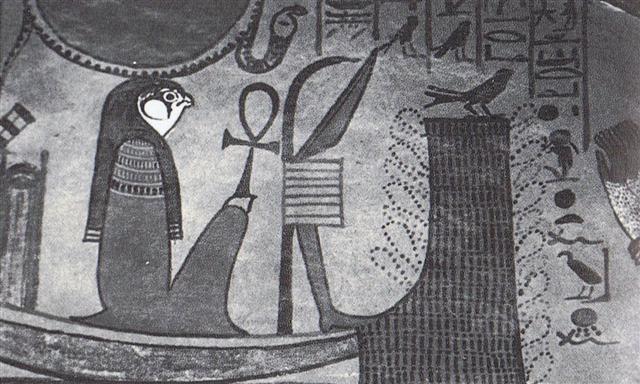324. Once again. The double-faced Janus could have signified the end of the old year in January followed by the beginning of the new year in February. Similarly was there Jupiter Julius half a year later. ... At the beginning of 44 B.C. - when Caesar was still alive - the Senate decided to raise statues of him in all the temples and to sacrifice to him on his birthday in the month Quintilis, which in honour of him was renamed July. He was raised to the status of a god (among the other gods of the state) under the name Jupiter Julius. Marcus Antonius, who this year was consul together with Caesar, became high priest and responsible for the ceremonies. In the middle of February, at the time of the old feast of Lupercalia [cfr Lupus = Wolf], he ran around naked and whipped the Roman ladies with thongs made from goat-skin [februa], in order to promote their fertility ... However, July-August had 31 + 31 = 62 days, whereas January-February had only 31 + 28 = 59 days. There were 3 days missing: ... Väinämöinen set about building a boat, but when it came to the prow and the stern, he found he needed three words in his rune that he did not know, however he sought for them. In vain he looked on the heads of the swallows, on the necks of the swans, on the backs of the geese, under the tongues of the reindeer. He found a number of words, but not those he needed. Then he thought of seeking them in the realm of Death, Tuonela, but in vain. He escaped back to the world of the living only thanks to his potent magic. He was still missing his three runes. He was then told by a shepherd to search in the mouth of Antero Vipunen, the giant ogre. The road, he was told, went over swords and sharpened axes. Ilmarinen made shoes, shirt and gloves of iron for him, but warned him that he would find the great Vipunen dead. Nevertheless, the hero went. The giant lay underground, and trees grew over his head. Väinämöinen found his way to the giant's mouth, and planted his iron staff in it. The giant awoke and suddenly opened his huge mouth. Väinämöinen slipped into it and was swallowed. As soon as he reached the enormous stomach, he thought of getting out. He built himself a raft and floated on it up and down inside the giant. The giant felt tickled and told him in many and no uncertain words where he might go, but he did not yield any runes. Then Väinämöinen built a smithy and began to hammer his iron on an anvil, torturing the entrails of Vipunen, who howled out magic songs to curse him away. But Väinämöinen said, thank you, he was very comfortable and would not go unless he got the secret words. Then Vipunen at last unlocked the treasure of his powerful runes. Many days and nights he sang, and the sun and the moon and the waves of the sea and the waterfalls stood still to hear him. Väinämöinen treasured them all and finally agreed to come out. Vipunen opened his great jaws, and the hero issued forth to go and build his boat at last ... Metaphorically they had all been swollen by an ogre, or a fish, or a swallow:
...Then the big Fish did swallow him, and he had done acts worthy of blame. But We cast him forth on the naked shore in a state of sickness, Therefore 365 = 59 + 122 + 62 + 122 = 181 + 184, just as the distances measured out by Aldebaran and Antares:
And thus there were probably 3 days' of 'cold food' after 59 calendar days. There were only 180 days between Aldebaran and Antares, but 183 days between Antares and Aldebaran. Possibly this was a factor which had influenced the creator of the G text when he located Aldebaran:
At the time of the Bull it had been, it seems, the return to visibility of Aldebaran which counted. MARCH 25 (84) was day 5 after day 79 (corresponding to *79 for Rigel at the time of rongorongo) and 360 + 5 = 365. ... Nut, whom the Greeks sometimes identified with Rhea, was goddess of the sky, but it was debatable if in historical times she was the object of a genuine cult. She was Geb's twin sister and, it was said, married him secretly and against the will of Ra. Angered, Ra had the couple brutally separated by Shu and afterwards decreed that Nut could not bear a child in any given month of any year. Thoth, Plutarch tells us, happily had pity on her. Playing draughts with the Moon, he won in the course of several games a seventy-second part of the Moon's light with which he composed five new days. As these five intercalated days did not belong to the official Egyptian calendar of three hundred and sixty days, Nut was thus able to give birth successively to five children: Osiris, Haroeris (Horus), Set, Isis and Nepthys ... MARCH 20 (79) - 16 (days before returning to visibility) = MARCH 4 (63) and at the time of rongorongo there were 63 glyphs (9 weeks) from the Navel of the Horse to the end of side b on the G tablet:
But we should move a further *79 - *64 = *15 precessional days back in time in order to find the corresponding origo according to the time-frame of Rigel:
|
|||||||||||||||||||||||||||||||||||||||||||||||||||||||||||||||||||||||||||||||||||||||||||||||||||||||||||||||||||||||||||||||||||||||||||||||||||














